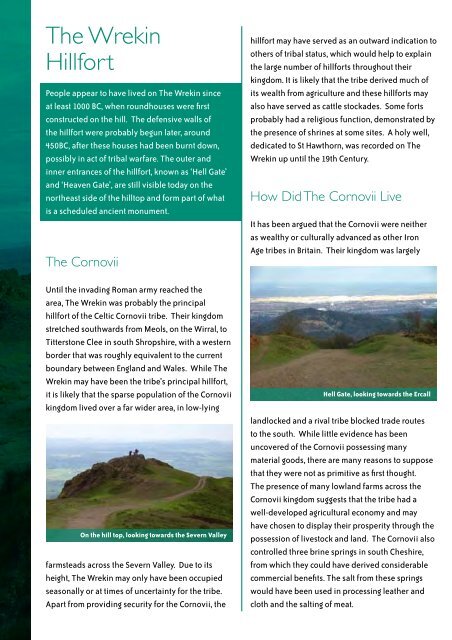All Round The Wrekin - Wellington Local Agenda 21 Group
All Round The Wrekin - Wellington Local Agenda 21 Group
All Round The Wrekin - Wellington Local Agenda 21 Group
You also want an ePaper? Increase the reach of your titles
YUMPU automatically turns print PDFs into web optimized ePapers that Google loves.
<strong>The</strong> <strong>Wrekin</strong><br />
Hillfort<br />
People appear to have lived on <strong>The</strong> <strong>Wrekin</strong> since<br />
at least 1000 BC, when roundhouses were first<br />
constructed on the hill. <strong>The</strong> defensive walls of<br />
the hillfort were probably begun later, around<br />
450BC, after these houses had been burnt down,<br />
possibly in act of tribal warfare. <strong>The</strong> outer and<br />
inner entrances of the hillfort, known as ‘Hell Gate’<br />
and ‘Heaven Gate’, are still visible today on the<br />
northeast side of the hilltop and form part of what<br />
is a scheduled ancient monument.<br />
<strong>The</strong> Cornovii<br />
Until the invading Roman army reached the<br />
area, <strong>The</strong> <strong>Wrekin</strong> was probably the principal<br />
hillfort of the Celtic Cornovii tribe. <strong>The</strong>ir kingdom<br />
stretched southwards from Meols, on the Wirral, to<br />
Titterstone Clee in south Shropshire, with a western<br />
border that was roughly equivalent to the current<br />
boundary between England and Wales. While <strong>The</strong><br />
<strong>Wrekin</strong> may have been the tribe’s principal hillfort,<br />
it is likely that the sparse population of the Cornovii<br />
kingdom lived over a far wider area, in low-lying<br />
On the hill top, looking towards the Severn Valley<br />
farmsteads across the Severn Valley. Due to its<br />
height, <strong>The</strong> <strong>Wrekin</strong> may only have been occupied<br />
seasonally or at times of uncertainty for the tribe.<br />
Apart from providing security for the Cornovii, the<br />
hillfort may have served as an outward indication to<br />
others of tribal status, which would help to explain<br />
the large number of hillforts throughout their<br />
kingdom. It is likely that the tribe derived much of<br />
its wealth from agriculture and these hillforts may<br />
also have served as cattle stockades. Some forts<br />
probably had a religious function, demonstrated by<br />
the presence of shrines at some sites. A holy well,<br />
dedicated to St Hawthorn, was recorded on <strong>The</strong><br />
<strong>Wrekin</strong> up until the 19th Century.<br />
How Did <strong>The</strong> Cornovii Live<br />
It has been argued that the Cornovii were neither<br />
as wealthy or culturally advanced as other Iron<br />
Age tribes in Britain. <strong>The</strong>ir kingdom was largely<br />
Hell Gate, looking towards the Ercall<br />
landlocked and a rival tribe blocked trade routes<br />
to the south. While little evidence has been<br />
uncovered of the Cornovii possessing many<br />
material goods, there are many reasons to suppose<br />
that they were not as primitive as first thought.<br />
<strong>The</strong> presence of many lowland farms across the<br />
Cornovii kingdom suggests that the tribe had a<br />
well-developed agricultural economy and may<br />
have chosen to display their prosperity through the<br />
possession of livestock and land. <strong>The</strong> Cornovii also<br />
controlled three brine springs in south Cheshire,<br />
from which they could have derived considerable<br />
commercial benefits. <strong>The</strong> salt from these springs<br />
would have been used in processing leather and<br />
cloth and the salting of meat.


